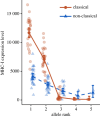Only rare classical MHC-I alleles are highly expressed in the European house sparrow
- PMID: 38378156
- PMCID: PMC10878800
- DOI: 10.1098/rspb.2023.2857
Only rare classical MHC-I alleles are highly expressed in the European house sparrow
Abstract
The exceptional polymorphism observed within genes of the major histocompatibility complex (MHC), a core component of the vertebrate immune system, has long fascinated biologists. The highly polymorphic classical MHC class-I (MHC-I) genes are maintained by pathogen-mediated balancing selection (PMBS), as shown by many sites subject to positive selection, while the more monomorphic non-classical MHC-I genes show signatures of purifying selection. In line with PMBS, at any point in time, rare classical MHC alleles are more likely than common classical MHC alleles to confer a selective advantage in host-pathogen interactions. Combining genomic and expression data from the blood of wild house sparrows Passer domesticus, we found that only rare classical MHC-I alleles were highly expressed, while common classical MHC-I alleles were lowly expressed or not expressed. Moreover, highly expressed rare classical MHC-I alleles had more positively selected sites, indicating exposure to stronger PMBS, compared with lowly expressed classical alleles. As predicted, the level of expression was unrelated to allele frequency in the monomorphic non-classical MHC-I alleles. Going beyond previous studies, we offer a fine-scale view of selection on classical MHC-I genes in a wild population by revealing differences in the strength of PMBS according to allele frequency and expression level.
Keywords: adaptive immunity; immune genes; major histocompatibility complex; pathogen-mediated selection; pathogens.
Conflict of interest statement
The authors declare no competing interests.
Figures



References
MeSH terms
Supplementary concepts
LinkOut - more resources
Full Text Sources
Other Literature Sources
Research Materials
